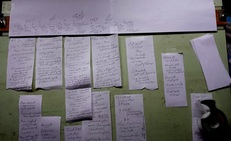A while back I was involved with a fairly tough critique partner who wrote in a vastly different genre than I. He was writing a 200K suspense/murder/mystery/drug & mind control novel while I was writing a simple horse story for fourth graders.
His biggest beef about my writing – foreshadowing. And of course real danger for my main character, an eleven year old girl who had a telepathic connection to her pony.
It was not a good fit.
My biggest mistake was that I let it get under my skin. But I eventually got over it. Then I did some research. For one thing, after re-reading some of his chapters, I recognized that his foreshadowing technique was actually almost pre-telling what was coming. I’m really not sure what category that falls into. Okay, so if a character, say a law enforcement officer, is approaching a potential bad-guy-hideout and slips the safety strap off his pistol, I’m going to look forward to a possible gun-battle. However, if the cop loosens his revolver, saying to himself “I’m sure I’m going to need this because this guy I’m after is crazy and I know he has an arsenal of weapons in there.” Well, that’s giving it away and since I know for sure what’s coming, I may just skim to see what’s next. (No that author didn’t write those words, that’s only an example. And he did get an agent.)
I did more reading.
A well-known children’s author who has won all sorts of rewards did the same thing in the first chapter by actually telling what the stakes were and how bad it could be right there in black and white. Instead of me looking forward to what might happen – be it good and wonderful, happy and funny, scary and adventuresome, I was no longer curious. I already knew. Sadly I couldn’t find the energy to keep reading. It was already told how dangerous it would be to approach the only means necessary to solve the big problem.
The best text for learning the technique of foreshadowing from both a writer’s perspective and a reader’s is THE LOTTERY, by Shirley Jackson, way back in 1948. And it still stands as the benchmark. Only a few glimpses, solitary items, which don’t really seem to add to the story – until the end.
What is foreshadowing? It’s an element in the story that you have no idea is there until the danger rises its scary face, or until the funniest thing in the world occurs. (Not all stories need to have death, murder, and mayhem involved to be really, really good.)
Foreshadowing is a passing glance at a picture on the wall, which may turn out to hold some secret vital to the outcome. And after dancing all around that non-remarkable painting, the reader is delighted to discover the clue hidden there. But if the author overstates the presence of the art, the reader will become frustrated when the MC doesn’t see it, or become bored with the whole story, and toss it in the corner without finishing.
In my children’s book, LEGEND OF THE SUPERSTITION GOLD, which is my third Black Pony book, I dedicate a chapter to putting shoes on the pony, while dropping information about the upcoming trail ride along with a few stories about the Lost Dutchman Gold. Why the whole chapter? Well, it’s short and full of horsey stuff. Plenty of dialog between Annie and the pony. A humorous dismissal of the legends by the farrier (in my opinion one of the strongest pieces of foreshadowing in the book). AND every single element in that first chapter is seen again – several times. Not only that, the shoes themselves become in integral part of the plot. But you don’t know that until you read further.
My second chapter is dedicated to a pair of spurs and how they come to be in the possession of the main character. The spurs once belonged to Annie’s grandfather. Her uncle has very little success in using them and passes them to her. The connection won’t be noticed until mid-point of the book, but will be totally understood at the climax. But you never will know that until you get there.
Other bits of foreshadowing include Annie looking at hieroglyphics – and feeling a strange presence. Midnight warns her a few times that ‘The Others’ are nearby as well. True, I have a rather slow chapter where the whole thing is dedicated to a few of the stories, which anyone can google, about the haunted Superstition Mountains and its hidden treasures. But, they are all seen again. Besides, to at least a few of us, those stories are juicy and wonderful.
But, if at any point in the story I would have written ‘X is about to happen’ you may not have been interested anymore. Why do I point out that riding in the soft sand of a dry wash could be dangerous? Because a flash flood is coming! That was likely the most telling foreshadowing in the whole story.
I’ll never say that I’m anywhere near as good at foreshadowing as Shirley Jackson, or in fact dozens of other authors out there, but the fact remains. You will never know what part of a scene foreshadows the coming event until after that event has occurs and it all comes together in a satisfactory ending.
A few examples of books using foreshadowing from Goodreads include, THE AGE OF MIRACLES by Karen Thompson Walker, published by Random House; Mo Willems’ THAT IS NOT A GOOD IDEA; Though this next one has mixed reviews because of adult content, THE TIME TRAVELER’S WIFE by Audrey Niffenegger, is pegged as a great book for foreshadowing.
One of my personal favorite authors is Linda Ulleseit, who writes a series of The Winged Horses. You know something is up when an outsider falls in love with a filly, and there is dark talk of a long forgotten village, but you don’t know what it is until it happens. And you know something is about to happen when a young rider is torn between a soon-to-be barn leader with an attitude - who will do anything to win, and a timid rider who has a fear of flying, but you are blown away by what happens – and you didn’t see it coming, until you read it again, and again, and again. (Yes, I read it that many times.)
Goodreads has more if you wish to look them up. Of course mine is one of the best (in my opinion). http://tinyurl.com/p6wm6kf
How well to you foreshadow the events in your story? Do you let it all out before it happens, or drop invisible hints that show their glory at the end?
I’d love to hear your stories and examples.


 RSS Feed
RSS Feed
